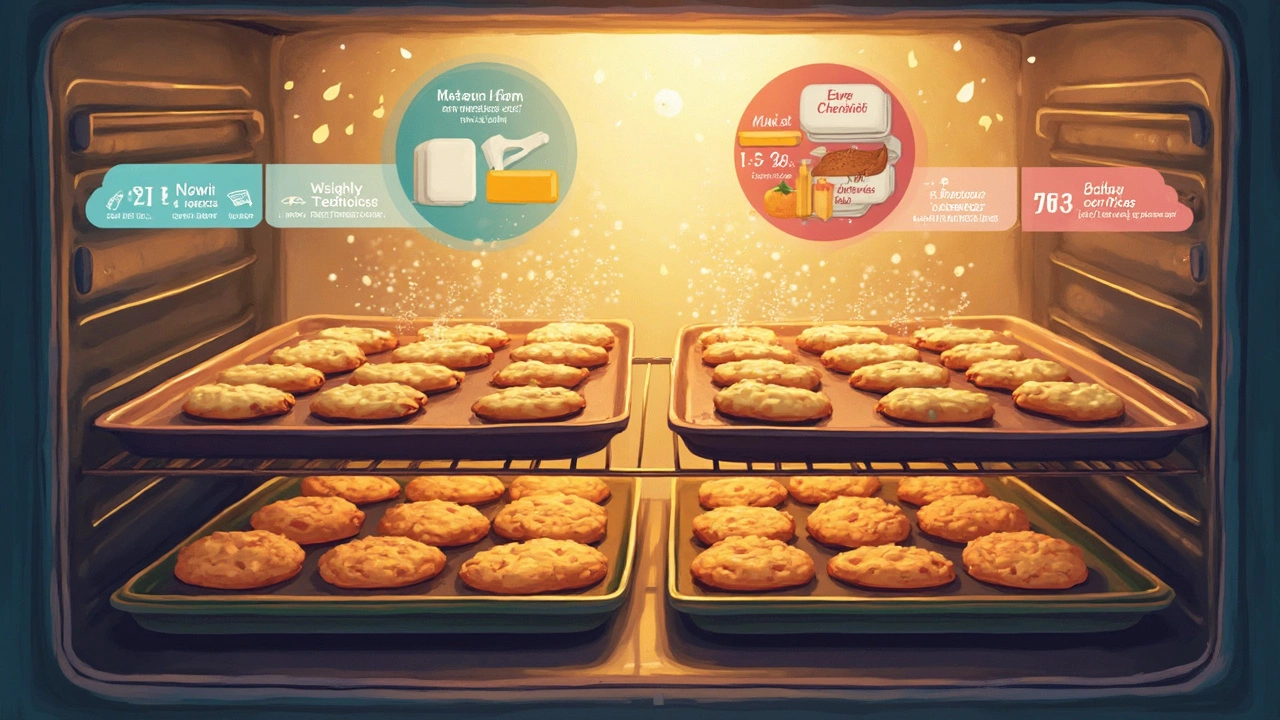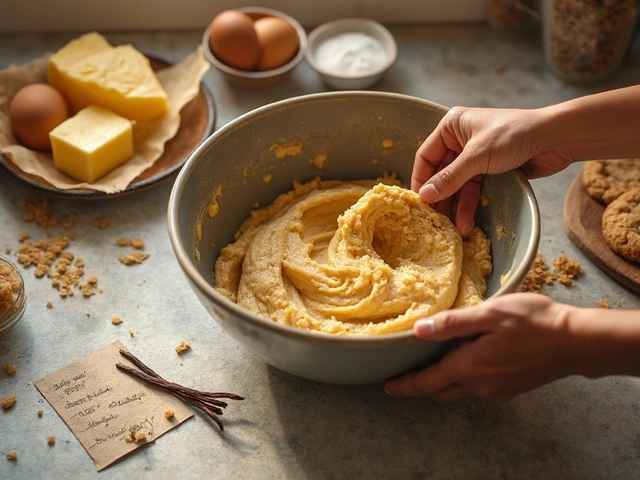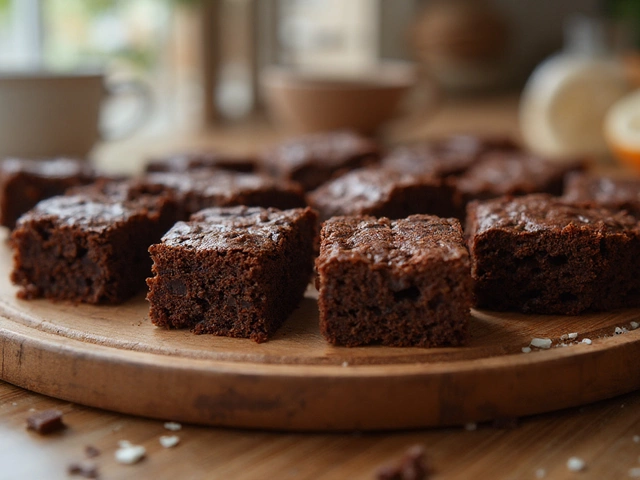
Ready to solve the mystery of why your cookies come out crunchy one day and delightfully soft the next? Let’s kick things off with something you might not expect: it’s less about luck, and more about tiny choices you make along the way—think sugar type, fat, and even the oven temperature.
If you just throw everything together and hope for the best, your results will bounce all over the place. But when you know what actually affects texture, things start to make sense. Maybe your favorite chocolate chip cookie is soft because you used brown sugar and baked it a minute less. Or that perfectly crisp peanut butter cookie? Thank the extra granulated sugar and longer baking time.
Baking is a bit like playing with building blocks. Swap out one part, like using melted butter instead of cold, and you get a whole new cookie personality. You don’t need fancy equipment or secret ingredients; just a few smart tweaks can totally transform your results.
- Cookie Texture Basics
- How Ingredients Make a Difference
- Baking Methods and Their Impact
- Easy Tricks for Your Perfect Cookie
Cookie Texture Basics
If you’re serious about homemade cookies, it pays to know what really decides if you get crunchy cookies or the dreamy soft cookies. At the heart of it, texture’s all about how ingredients interact and how heat works its magic in your oven. We're not talking guesswork—there’s science going on.
Here’s the quick truth: cookies that are crunchy tend to lose more moisture during baking, while soft cookies hang on to that moisture. Sounds simple, right? But the trick is how you get there. Think about the mix of sugar types, the fat you use, and even egg ratios. All these bits add up to the final bite you get.
Cookies with more granulated sugar and less brown sugar usually bake up crisp, while brown sugar—which brings molasses into the mix—keeps things soft and even a little chewy. Switch up the egg situation by using yolks only, and your cookies get softer. Egg whites? Expect a little crunchier feel.
Fat’s another big player. If you stick with butter, you’ll get better flavor, but the way it’s used matters: melted butter spreads a cookie thin (think more crunch) while cold, solid butter holds things together for a softer bite. Even shortening and oil can change the story.
"Texture is not just about science, but also about a baker’s choices. The tiniest ingredient tweaks flip the textures, so every batch is a new experiment." — Sally McKenney, baking expert at Sally’s Baking Addiction
Don’t forget baking time and temperature—they matter a ton. A few more minutes or a 15-degree jump in heat, and suddenly your cookie texture leans crunchier. Pull them out a tad earlier, and softness wins out.
Want a super simple trick? If you’ve got a batch of both kinds and aren’t sure who likes what, here’s a cheat sheet:
- For crunchy cookies: Bake longer at a slightly lower temp (around 325°F), use more white sugar, and less moisture.
- For soft cookies: Bake just until set at a higher temp (350°F to 375°F), use more brown sugar, and add a extra yolk or even a splash of milk.
It’s all about finding your perfect bite. Every small choice really adds up.
How Ingredients Make a Difference
If you want to master cookie texture, you’ve got to get real about what’s actually happening in the bowl. The difference between crunchy cookies and soft cookies comes down to a few main ingredients—and how you use them. Here’s what really matters:
- Sugar: White (granulated) sugar leads to crunchier cookies because it helps moisture evaporate. Brown sugar, with all its extra molasses, keeps cookies soft and chewy. Want a hybrid? Mix both types.
- Butter vs. Oil: Butter gives cookies that crispy edge when baked longer, but also adds flavor. Using oil (like canola or vegetable) tends to make cookies soft and sometimes even cakey. Melted butter will make your dough spread and get thinner, which often means more crunch.
- Eggs: Eggs add moisture. One egg will keep cookies fairly soft, but adding an extra yolk makes them even more tender and chewy. If you skip the egg altogether, expect a drier, crispier result.
- Flour: More flour usually means thicker, less spread-out cookies. Less flour gives you thinner, crispier treats. Measuring flour carefully (use a kitchen scale if you can) has a huge impact.
- Baking Soda vs. Baking Powder: Baking soda spreads cookies out and helps them brown and crisp. Baking powder puffs up your cookies, so you get lighter, cakier results.
Here’s a quick peek at how the most common ingredients stack up in homemade cookies:
| Ingredient | Makes Cookies... |
|---|---|
| White Sugar | Crunchy |
| Brown Sugar | Soft/Chewy |
| Melted Butter | Thin & Crisp |
| Cold/Softened Butter | Thick & Soft |
| More Flour | Cakey |
| Egg White | Crispy |
| Extra Yolk | Chewy |
If you’re aiming for that perfect cookie texture, these are the dials to turn. Next time you bake, consider swapping out just one ingredient or tweaking an amount. Even a little change (like switching white sugar for brown) can shift the whole game. It’s that simple—and, honestly, way more fun than hoping for random results.

Baking Methods and Their Impact
Your oven isn’t just a box that blasts heat. How you use it totally changes your cookie texture—crunchy or soft cookies are often the direct result of baking method decisions, not just your ingredient list.
Temperature plays a huge role. Cranking up the oven to 375°F or higher makes cookies crunchy faster by browning the outside before the inside sets. If you bake at 325°F, you give your soft cookie time to spread and stay moist, because the lower heat gently dries it out more slowly. Timing matters, too: take your cookies out while the middle looks barely set, and you’ll get that soft, chewy feel after they cool. Leave them in just a couple minutes longer, and you’ll see them turn crisp around the edges and even throughout.
Where you bake your cookies in the oven can make a big difference. The middle rack gives you the most even heat, but if you want extra color on the bottom (hello, snappy cookies), use the lower rack. If you’re baking two trays at once, swap and rotate halfway through—most ovens aren’t perfectly equal top to bottom or front to back.
- For crunchy cookies: High heat (375°F+), longer baking, and don’t underbake. Spread cookies thin for maximum crispiness.
- For soft cookies: Lower heat (about 325°F), slightly underbake, and let cookies cool on the baking sheet. Thicker dough globs help, too.
Rack position, baking time, and temperature can seem small, but try changing just one of these next time and notice the difference. That feeling when you finally nail your perfect cookie? It’s all about these easy tweaks.
| Temperature | Baking Time (min) | Texture Result |
|---|---|---|
| 325°F | 12-15 | Soft, chewy |
| 350°F | 10-12 | Balanced, soft with crisp edges |
| 375°F | 8-10 | Crispy and crunchy |
Easy Tricks for Your Perfect Cookie
Achieving the right cookie texture isn’t just luck. It’s all about smart baking moves, and you don’t need to be a pro to nail it. Let’s break down the tricks that’ll help you choose whether your cookies turn out crunchy or soft—no secret handshake required.
- For Soft Cookies: Swap in more brown sugar than white. Brown sugar packs in more moisture, giving you that melt-in-your-mouth chew, thanks to its molasses content.
- Use real butter and don’t fully melt it. Softened butter holds some air, and that little bit of fluffiness keeps cookies tender. If your recipe calls for oil, know that it’ll lean softer too.
- Shorten the bake time. Pull your cookies out just when the edges firm up, and don’t wait for a golden-brown top. Soft cookies keep setting as they cool.
- Let your dough rest in the fridge. Even a 30-minute chill lets flour absorb more moisture, giving a softer bite. Some folks leave dough overnight for even better results.
- For Crunchy Cookies: Go lighter on brown sugar and heavier on granulated sugar. White sugar draws out moisture while baking, which equals more snap.
- Make your cookies thinner. Either flatten dough balls or roll dough out a bit. Thinner cookies bake fast and get crisp.
- Bake a bit longer—but watch the oven like a hawk. Cookies go from golden to burnt surprisingly fast. Move them to a rack as soon as they’re done to avoid sogginess.
- Skip chilling the dough. Baking dough right away keeps it from absorbing extra moisture, which makes cookies crunchier.
Want some numbers to back this up? Take a look at this quick comparison table:
| Trick | Boosts Crunchy Cookies | Boosts Soft Cookies |
|---|---|---|
| Brown Sugar | ✗ | ✓ |
| White Sugar | ✓ | ✗ |
| Bake Time | Longer | Shorter |
| Dough Chilling | ✗ | ✓ |
| Butter (Softened, Not Melted) | ✗ | ✓ |
The next time you want to control that cookie texture, check your sugars, fat, dough temp, and bake time. These tweaks are what really decide if you end up with a batch of crunchy cookies or ultra-soft cookies. Personalize each batch by adjusting just one thing at a time, and you’ll have your perfect recipe in no time.





